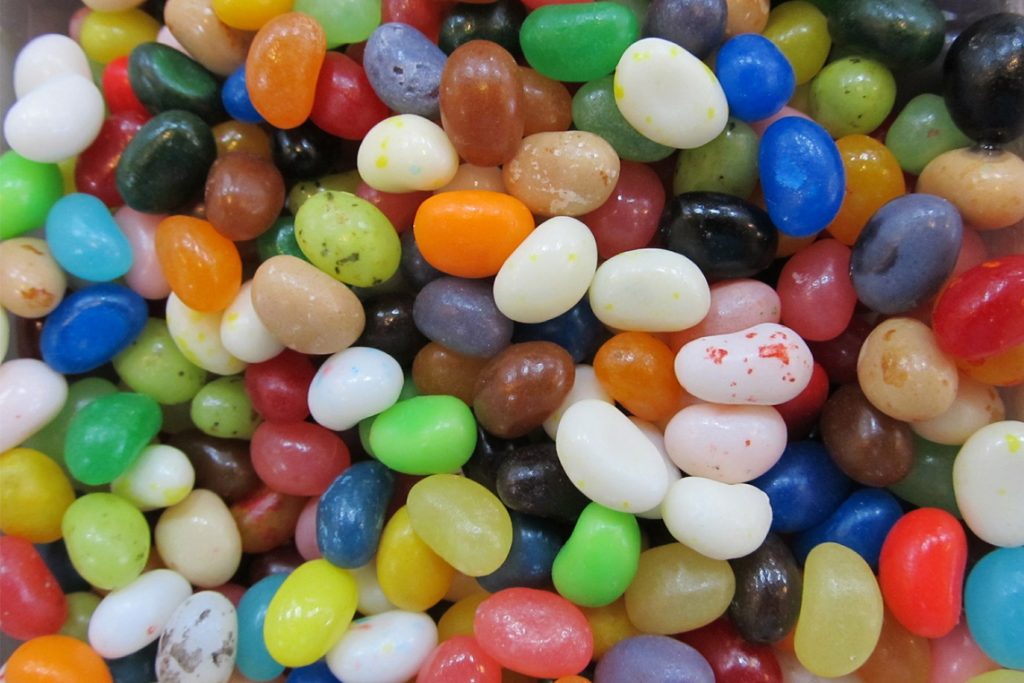Unless you’re an uber-fan, you probably don’t think about jelly beans a whole lot until Easter rolls around — then the little candies take center stage. But what do you really know about these sweet pops of flavor? Here are some juicy details.
1. It can take 7 to 14 days to make A jelly bean.
Making jelly beans is no easy task. It requires many steps from liquifying sugar and flavors to pouring into tiny bean-shaped molds and letting dry overnight. The candies then undergo a process called “panning.” They’re transferred to a rotating drum where flavors and colors are added as they spin. Sugar is then added to create the bean’s hard exterior shell. Finally, a hot syrupy wax is applied to give them their shine. After all of that, the beans still need to go through packing and shipping.
2. the battle for favorite flavor.
For two decades, Very Cherry held the top spot as America’s favorite Jelly Belly jelly bean flavor until Buttered Popcorn bumped it out of first place in 1998. In 2003, Very Cherry moved back to first place.
Geography and age also dictate our tastes. While Very Cherry is most popular in North and South America, lemon lime is most popular in Asia, bubble gum in Australia, tutti-frutti in Europe, and berry blue in the Middle East.
Both adults and children love cherry, but grown-ups opt for buttered popcorn, coconut, juicy pear and licorice. Kids go crazy for berry blue, green apple, raspberry and sour apple.
3. jelly Bean beginnings
The first jelly beans were created by an unknown American candy maker sometime in the 19th century. An advertisement in 1861 suggests sending jelly beans to soldiers in the Union Army during the Civil War.
While jelly beans are considered to be as American as apple pie, experts believe they are a descendant of the Mid Eastern Turkish Delight — a chewy jelly and powdered sugar confection — that dates back thousands of years.
4. Why the bean shape?
The American diet was dominated by beans in the 1800s. Candies of the day were often made into other common shapes of the era including vegetables, chestnuts, carrots and turnips.
5. Easter Origins
It wasn’t until the 1930s that jelly beans became part of Easter traditions. Their inclusion was probably due to their egg-like appearance in nests or baskets.
6. Christmas candy
Before the 1930s, jelly beans were considered a Christmas time confection. It wasn’t until their resemblance to eggs was noticed that Easter adopted them for its own. Christmas is still the second most popular holiday for jelly bean sales.
7. jelly beans in washington
The popularity of jelly beans really took off when Ronald Reagan, then running for governor of California, snacked on jelly beans in an effort to quit smoking. He received regular shipments of Jelly Belly beans from the Herman Goelitz Candy Company while he served as governor (1967-1974). After Reagan was elected to the Oval Office, he famously kept a jar of jelly beans on his desk. Reagan even sent jelly beans as a treat for the astronauts on the Challenger space shuttle in 1983.
8. Red, White, and Beans
That wasn’t the end of Ronald Reagan’s jelly bean affair. He is credited with creation of the blueberry jelly bean. The Goelitz company wanted to send Reagan red, white, and blue jelly beans for his Inauguration festivities, but while it had red (cherry) and white (coconut) candies, it had no blue beans. More than 40 million jelly beans were consumed during the event.
9. ‘Jelly-bean’ was once used as slang
During the 1910s and 1920s, if you called a man a “jelly bean” you were calling him a ladies man — the kind of guy you wouldn’t want to bring home to Mom and Dad. A “Jelly-bean” dressed stylishly, but had few other respectable qualities.
10. Millions of jelly beans
Enough jelly beans are eaten in a year to circle the Earth more than five times.

Also see, Fun facts about Peeps you never knew.




